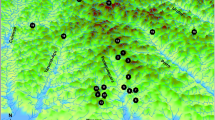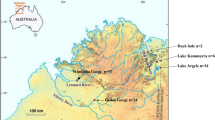Abstract
In Bulgaria, chamois (Rupicapra rupicapra balcanica) are protected by law and it has been recommended to assess their genetic diversity, level of inbreeding, and extent of introgression by Alpine chamois (R. r. rupicapra) that were released in the last century in the Rhodope Mountains. Chamois (n = 81) collected between 2009 and 2013 at the “Izvora State Hunting Reserve” (ISHR, western Rhodopes, a major source for chamois translocations in Bulgaria; census size: 200–250) were screened for allelic variability at 12 microsatellite loci and compared to chamois (R. r. rupicapra, n = 135) from six populations in the Austrian Alps. Indices of genetic variability were significantly lower for the ISHR population than for the Austrian populations. A significant bottleneck signal was observed for the ISHR population, but no distinct inbreeding signal due to non-random mating. F-statistics, absolute genetic distances, Bayesian STRUCTURE and assignment analyses, and a factorial correspondence analysis concordantly indicated distinct differentiation between the ISHR and Austrian chamois. STRUCTURE identified some few ISHR chamois as possibly introgressed by Alpine chamois. ONeSAMP revealed effective population size estimates of Ne ≈ 50 for the ISHR population. A reduction of shooting quotas, a reinforcement of poaching control, and exchanging chamois with other Bulgarian populations should increase its Ne to prevent further loss of genetic variability. Screening for introgression should be extended to other Bulgarian populations, particularly to areas where Alpine chamois were released in the past; and it should accompany all translocations, to prevent possible dissemination of introgressed chamois.


Similar content being viewed by others
References
Adamic M, Jerina K (2010) Ungulate management in Europe in the XXI Century Slovenia. In: Apollonio M, Andersen R, Putman R (eds) European ungulates and their management in the 21st century. Cambridge University, Cambridge, pp 507–527
AEFA (2006) Game numbers in Bulgaria. Archive of the Executive Forest Agency of Ministry of Agriculture and Foods of R. Bulgaria, Sofia
Avramov S, Valchev KD (2010) Balkan chamois status and action plan in Bulgaria. Galemys 22(special issue):561–574
Belkhir K (2004) GENETIX V. 4.0, logiciel sous WindowsTM pour la genetique des populations. Laboratoire Genome, Populations, Interactions CNRS UMR 5000, Universite de Montpellier II, Montpellier
Buzan EV, Bryja J, Zemanová B, Kryštufek B (2013) Population genetics of chamois in the contact zone between the Alps and the Dinaric Mountains: uncovering the role of habitat fragmentation and past management. Conserv Genet 14:401–412
Chapuis M-P, Estoup A (2007) Microsatellite null alleles and estimation of population differentiation. Mol Biol Evol 24:621–631
Corlatti L, Lorenzini R, Lovari S (2011) The conservation of the chamois Rupicapra spp. Mamm Rev 41:163–174
Corlatti L, Béthaz S, von Hardenberg A, Bassano B, Palme R, Lovari S (2012) Hormones, parasites and male mating tactics in Alpine chamois: identifying the mechanisms of life history trade-offs. Anim Behav 84:1061–1070
Corlatti L, Caroli M, Pietrocini V, Lovari S (2013) Rutting behaviour of territorial and nonterritorial male chamois: is there a home advantage? Behav Proc 92:118–124
Cornuet JM, Luikart G (1996) Description and power analysis of two tests for detecting recent population bottlenecks from allele frequency data. Genetics 144:2001–2014
Cornuet JM, Piry S, Luikart G, Estoup A, Solignac M (1999) New methods employing multilocus genotypes to select or exclude populations as origins of individuals. Genetics 153:1989–2000
Couturier M (1938) Le chamois. Arthaud, Grenoble, 855 pp
Crawford NG (2010) SMOGD: software for the measurement of genetic diversity. Mol Ecol Res 10:556–557
Crestanello B, Pecchioli E, Vernesi C, Mona S, Martínková N, Janiga M, Hauffe HC, Bertorelle G (2009) The genetic impact of translocations and habitat fragmentation in Chamois (Rupicapra) spp. J Hered 100:691–708
Earl DA (2012) vonHoldt BM (2012) STRUCTURE HARVESTER: a website and program for visualizing STRUCTURE output and implementing the Evanno method. Conserv Genet Res 4:359–361. doi:10.1007/s12686-011-9548-7 core version: vA.1 March 2012, web version: v0.6.92 March
Evanno G, Regnaut S, Goudet J (2005) Detecting the number of clusters of individuals using the software STRUCTURE: a simulation study. Mol Ecol 14:2611–2620
Falush D, Stephens M, Pritchard JK (2003) Inference of population structure using multilocus genotype data: linked loci and correlated allele frequencies. Genetics 164:1567–1587
Frankham R (1995) Effective population size/adult population size ratios in wildlife: a review. Genet Res 66:95–107
Frankham R, Ballou JD, Briscoe DA (2002) Introduction to Conservation Genetics. Cambridge University Press, Cambridge 617 pp
Genov P, Massei G, Gànĉev R (1990) Verbreitung und zahlenmäßige Stärke der Gemse (Rupicapra rupicapra balcanica Bolkay, 1925) in Bulgarien. Z Jagdwiss 36:1–8
Golemansky V (ed) (2011) Red data book of the Republic of Bulgaria, vol 2 – Animals. The Bulgarian Academy of Sciences & Ministry of Environment and Water, Sofia. www.e-ecodb.bas.bg/rdb/bg/ (in Bulgarian)
Goudet J (1995) Fstat Version 1.2. A computer program to calculate F-statistics. J Hered 86:485–486
Goudet J (2001) Fstat, A program to estimate and test gene diversities and fixation indices (Version 2.9.3). http://www.unil.ch/izea/softwares/fstat.html
Hale ML, Burg TM, Steeves TE (2012) Sampling for microsatellite-based population genetic studies: 25 to 30 individuals per population is enough to accurately estimate allele frequencies. PLoS One 7:e45170
Hristovich K (1939) Chamois. Priroda 4:1–3
Inc. SPSS 10.0.1 c. SPSS company, Inc
Jost L (2008) GST and its relatives do not measure differentiation. Mol Ecol 17:4015–4026
Keller LF, Waller DM (2002) Inbreeding effects in wild populations. Trends Ecol Evol 17:230–241
Keller MC, Visscher PM, Goddard ME (2011) Quantification of inbreeding due to distant ancestors and its detection using dense single nucleotide polymorphism data. Genetics 189:237–249
Kossarek LM, Finlay O, Grosse WM, Su X, McGraw RA (1994) Five bovine dinucleotide repeat polymorphisms: RM026, RM029, RM032, RM033 and RM038. Anim Genet 25:296–297
Lorenzini R (2005) A panel of polymorphic microsatellites in the threatened Apennine chamois (Rupicapra pyrenaica ornata). Mol Ecol Notes 5:372–374
Luikart G (2010) Estimation of census and effective population sizes: the increasing usefulness of DNA-based approaches. Conserv Genet 11:355–373
Markov G (1959) Mammals in Bulgaria. Science and Art, Sofia, 155 pp
Markov G (2010) Skull and horn features of chamois from Bulgaria: morphometric evidence for its taxonomic detachment. Galemys 22:11–30
Markov G, Nivov N, Andreev R (2013) Craniological variation of the Balkan chamois, Rupicapra rupicapra balcanica from Bulgaria. Folia Zool 62:200–206
Paetkau D, Slade R, Burden M, Estoup A (2004) Direct, real-time estimation of migration rate using assignment methods: a simulation-based exploration of accuracy and power. Mol Ecol 13:55–65
Paule L, Krajmerová D, Romšáková I, Schlosserová D (2012) Conservation genetics: new tool for wildlife management and nature conservation. International symposium on hunting, modern aspects of sustainable management of game population. Zemun-Belgrade, Serbia, 22–24 June 2012, pp 70–74
Peréz T, Albornoz J, Dominguez A (2000) A panel of bovine and caprine microsatellites suitable as markers in chamois. Anim Genet 31:344–345
Peréz T, Albornoz J, Domínguez A (2002) Phylogeography of chamois (Rupicapra spp.) inferred from microsatellites. Mol Phylogenet Evol 25:524–534
Petrov P (1965) On the distribution and population number of the chamois (Rupicapra rupicapra L.) in Bulgaria. For Sci II 2:153–166
Piry S, Alapetite A, Cornuet J-M, Paetkau D, Baudouin L, Estoup A (2004) GeneClass2: a software for genetic assignment and first-generation migrant detection. J Hered 95:536–539
Pritchard JK, Wen W (2004) Documentation for the STRUCTURE Software Version 2. Chicago. http://www.pritch.bsd.uchicago.edu/software/structure21.html
Pritchard JK, Stephens P, Donnelly P (2000) Inference of population structure using multilocus genotype data. Genetics 155:945–959
Rannala B, Mountain JL (1997) Detecting immigration by using multilocus genotypes. Proc Natl Acad Sci USA 94:9197–9201
Raymond M, Rousset F (1995) Genepop (version 1.2): population genetics software for exact tests and ecumenism. J Hered 86:248–249
Reed DH, Frankham R (2003) Correlation between fitness and genetic diversity. Conserv Biol 17:230–237
Rhugetti M, Toïgo C, Von Hardenberg A, Rocchia E, Festa-Bianchet M (2011) Effects of an exceptionally snowy winter on chamois survival. Acta Theriol 56:329–333
Rodríguez F, Pérez T, Hammer SE, Albornoz J, Domínguez A (2010) Integrating phylogeographic patterns of microsatellite and mtDNA divergence to infer the evolutionary history of chamois (genus Rupicapra). BMC Evolut Biol 10:222
Rossi L, Meneguz P, De Martin P, Rodolfi M (1995) The epizootiology of sarcoptic mange in chamois Rupicapra rupicapra from the Italian Eastern Alps. Parassitologia 37:233–240
Schaschl H, Suchentrunk F, Morris DJ, Ben Slimen H, Smith S, Arnold W (2012) Sex-specific selection for MHC variability in Alpine chamois. BMC Evol Biol 12:20
Soglia D, Rossi L, Cauvin E, Citterio C, Ferroglio E, Maione S, Meneguz PG, Spalenza V, Rasero R, Sacchi P (2010) Population genetic structure of Alpine chamois (Rupicapra r. rupicapra) in the Italian Alps. Eur J Wildl Res 56:845–854
Spiridinov J, Genov P (1997) 6.3. Bulgaria. in: Shackleton, D. M. 8ed. an the IUCN/SSC Caprinae Specialist Group. 1997. Wild Sheep and Goats and their Relatives. Status Survey and Conservation Action Plan for Caprinae. IUCN, Gland, Switzerland and Cambridge, U.K., 390 + vii pp (pp 86–89)
S-PLUS 6.2: Copyright (c) , 2003. Insightful Corp.: Copyright Lucent Technologies
Srikawan S, Woodruff DS (2000) Genetic erosion in isolated small-mammal populations following rainforest fragmentation. In: Young AG, Clarke GM (eds) Genetics, demography and viability of fragmented populations. Cambridge University Press, Cambridge, pp 149–172
Tallmon DA, Koyuk A, Luikart GH, Beaumont MA (2008) ONeSAMP: a program to estimate effective population size using approximate Bayesian computation. Mol Ecol Res 8:299–301
The IUCN Red List of Threatened Species™ 2012.1. http://www.iucnredlist.org/details/39255/0
Valchev K, Andonov K, Popgeorgiev G, Plachijski D, Avramov S (2006) Action plan for the Chamois in Bulgaria: 2007–2016. BBF—SFA, Sofia 93 pp
Van Oosterhout C, Hutchinson WF, Wills DPM, Shipley P (2004) MICROCHECKER: software for identifying and correcting genotyping errors in microsatellite data. Mol Ecol Notes 4:535–538
Weir BS, Cockerham CC (1984) Estimating F-statistics for the analysis of population structure. Evolution 38:1358–1370
Yankov Y, Valchev K, Milushev V, Varlyakov I (2011) Raising the effectiveness and minimizing the risk in the caturing of chamois for resettlement. Trakia J Sci 9:62–70
Acknowledgments
We are indebted to all hunters and the hunting organisations in Bulgaria and Austria that provided genetic samples, to Mrs. Anita Haiden (Vienna) for laboratory work, to two anonymous reviewers, as well as to Prof. G. Segelbacher, the associate editor, for their valuable comments and suggestions.
Author information
Authors and Affiliations
Corresponding author
Rights and permissions
About this article
Cite this article
Markov, G., Zhelev, P., Ben Slimen, H. et al. Population genetic data pertinent to the conservation of Bulgarian chamois (Rupicapra rupicapra balcanica). Conserv Genet 17, 155–164 (2016). https://doi.org/10.1007/s10592-015-0768-3
Received:
Accepted:
Published:
Issue Date:
DOI: https://doi.org/10.1007/s10592-015-0768-3




